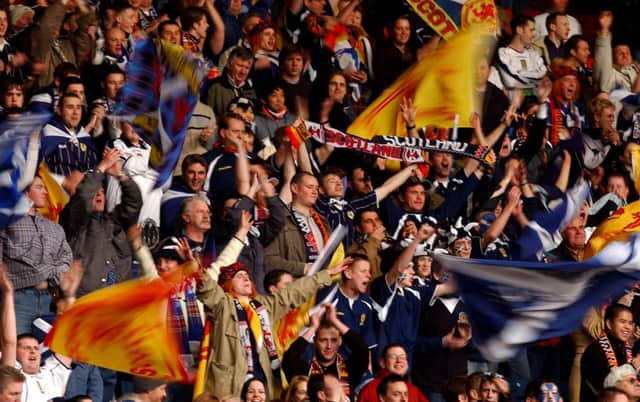Martyn McLaughlin: US-inspired music drowning out fan culture


Inverclyde in the 1980s was not the obvious fit for a dash of Venetian decadence, but perhaps for that very reason, it persisted. To this day, it is regarded as one of the club’s unofficial anthems, carried on anew by one bemused generation of supporters after the next.
Followers of every club will have their own peculiar inheritances to belt out in unison at 3:05pm on any given Saturday. The best among them, regrettably, are not fit for newsprint, but cumulatively they are a celebration of fan culture, a term that until recently, was viewed by the authorities as a byword for violence and disorder. As the game has evolved and the facilities improved, that stigma has fallen away. The price for progress, however, is paid in other ways, as attending a game increasingly becomes a consumer experience, where supporters meekly conform to the role of customers.
Advertisement
Hide AdAdvertisement
Hide AdHow else to explain the depressing trend of goal music which blares out from a stadium’s public address system every time the home side put the ball in the back of the net? This innovation’s creep into our national sport has been gradual yet pronounced over the course of the past decade, replacing the clatter of a Mitre striking a corrugated iron roof as the natural soundtrack to our game.
Anyone going through the turnstiles at Hampden to see Scotland play is in for a particularly grating example of this US-inspired trend. After a public vote, the Scottish Football Association has announced that the dance song, Bits ’n’ Pieces, will replace The Proclaimers’ (I’m Gonna Be) 500 Miles as the number that is played every time the national side score during the 2018 World Cup qualifying campaign. Now, a bam anthem that is routinely heard thudding from subwoofers in souped up Renault 5 GT Turbos will grace Scottish football’s grandest stage.
The wealth of attacking options at manager Gordon Strachan’s disposal mean the tune’s composers can look forward to a royalty cheque for around £2.40, but what does it say of the SFA’s regard for the Tartan Army that it deems goal music necessary in the first instance?
Anyone who has cheered on a Scotland victory will know that, even in Hampden, where the layout of the stadium does its best to suppress any sense of atmosphere instead of promote it, the roar of the crowd does not require a pre-packaged theme tune.
Advocates of the ditties claim they are an innocuous means of enlivening proceedings at matches and engineering a communal, celebratory singalong. It is an argument that makes sense before and after games, when a well-chosen coda can sum up the tone of the fixture and the supporters’ emotions, but playing songs during play itself simply reduces fans to the role of observers when they should be participants.
Sometimes, the pain of a loss is softened by the banter from the stands. I was at Hampden for the excruciating 2-1 defeat to Italy in 2007 which put paid to Scotland’s hopes of reaching Euro 2008. I don’t remember much of Christian Panucci’s late goal, but a chant that went around – “We’re gonna deep fry your pizzas” – will live long in the memory.
Embracing goal music is the first step towards eradicating such homespun compositions, which draw on a deep well of perspicacity, playfulness and immaturity, usually all at once. Why should we ever wish to change it?
There have been very few attempts to identify and preserve the eccentricities of the football crowd. The best example is The Soccer Tribe by anthropologist Desmond Morris, who recorded and transcribed a clutch of games in the old English First Division in the 1980s. The results probably threw up some choice critiques of underperforming centre halves, but re-reading the book today, what stands out is the range and frequency of the chants.
Advertisement
Hide AdAdvertisement
Hide AdThe majority of games, Morris found, featured up to 160 individual songs or chants, around one every 30 seconds. No doubt a minority dwelt on unsavoury prejudices of the era, but it is rare to encounter even a quarter of that number at today’s games.
There is a place for pop music at football games, though there is no need to impose it. If left alone, it can be assimilated into the crowd’s repertoire and reshaped by their renditions. Jack White, who wrote Seven Nation Army, now a stalwart of stands across Europe, made a gracious observation when he acknowledged its popularity among football fans. “Nothing is more beautiful than when people embrace a melody and allow it to enter the pantheon of folk music,” he said.
That spontaneity is the lifeblood of supporter culture and we should resist all attempts to tell us what to sing and when to sing it.
In any case, sometimes a long, lingering silence is the most rewarding. Back at Cappielow a few years back, a dreary draw was being played out one winter morning as a tradesman carried out repairs to the grandstand roof.
A lone wit piped up: “Gonnae shut it up there? Some of us are trying to get to sleep.”